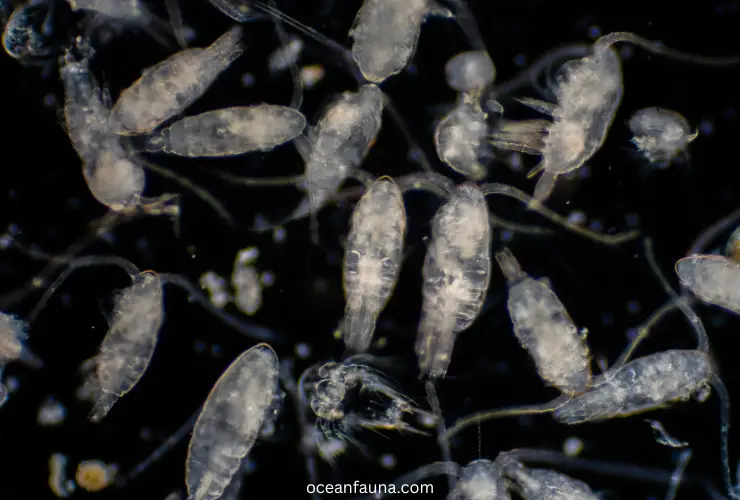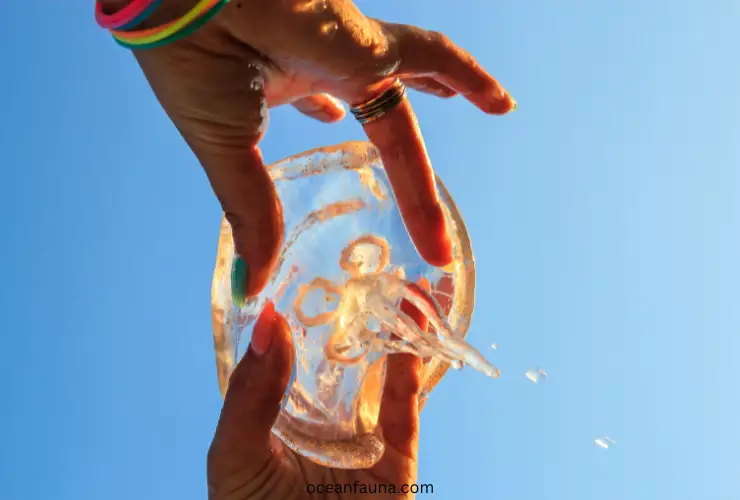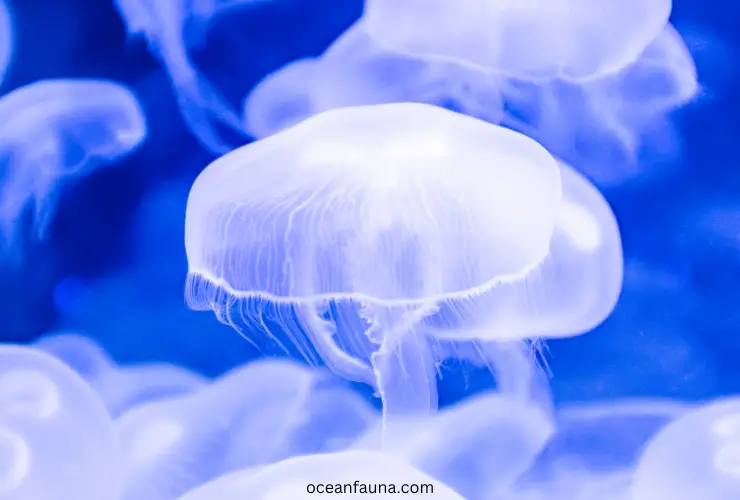Moon jellyfish are primarily carnivorous. The stable food of moon jellyfish is zooplankton (a microscopic organism). Besides this, they fed on small fish, larvae, mollusks, crustaceans, fish eggs, and other small aquatic creatures.
Now let’s have a closer look at moon jellyfish’s food and diet habits in detail.

What Do Moon Jellyfish Eat in the Wild?
Moon Jellyfish feed on planktonic organisms in the wild. Their diet also consists of tiny organisms such as small fish, larvae, mollusks, crustaceans, fish eggs, and other small aquatic creatures.
Did you know the feeding habits of moon jellyfish tell you a different story? By relying on passive and active behaviors, moon jellyfish paralyze and ingest their prey. When their diet is over, you can observe the food items they intake in their stomach (a flower-shaped organ in the bell).
Interestingly, moon jellyfish eat only animals that stick to their tentacles in wild territories. It doesn’t matter how big or small the prey is; they just love to consume the creatures found naturally.
Sound mysterious? Right! Yes, I have more details about the diet of moon jellyfish in the wild. Do you know bizarre ocean sunfish and sea turtles are their favorite snacks in the wild?
What Do Moon Jellyfish Eat As Pets?
If you have pet moon jellyfish, you’ll need to provide them with a diet that is similar to what they would eat in the wild. Below is a list of their preferred food.

Feed on planktonic organisms
Since moon jellyfish primarily feed on planktonic organisms, the ideal food for pet moon jellyfish is zooplankton.
Feeding tips- One option for pet moon jellyfish is to culture your zooplankton at home. This can be done by setting up a culture of brine shrimp. These small organisms can be grown in a container with preferred water conditions and food sources. And then fed to the jellyfish.
Purchase frozen planktonic food
Another option is to purchase frozen planktonic food from a pet store. These products can be mixed with water and then fed to the jellyfish.
Notably, that moon jellyfish are delicate creatures and can be easily harmed by improper feeding. Overfeeding can cause excess waste in the tank, leading to poor water quality and potential health problems for the jellyfish.
Feeding Guideline- Underfeeding can cause the jellyfish to become weak and unhealthy. It’s important to follow feeding guidelines for your specific jellyfish species. Monitor their health and behavior to ensure they get the right amount of food.
How Often Do Moon Jellyfish Eat?
Moon jellyfish eat once a day, every day. The frequency and amount of food that moon jellyfish need will depend on several factors, including their age, size, and overall health. As a general guideline, juvenile moon jellyfish may require smaller, more frequent feedings.
Adult jellyfish may require larger, less frequent feedings. Overfeeding should be avoided as it can result in poor water quality and possible health issues for the jellyfish.
When feeding moon jellyfish, it’s important to observe their behavior and adjust their feeding schedule as needed. They are likely hungry and can be fed by actively swimming and extending their tentacles.
Remember! If they are not showing interest in their food, it may be a sign that they are full or that the water quality in the tank needs to be improved.
How Does a Moon Jellyfish Eat?
Moon jellyfish eat using their tentacles (covered with stinging cells called nematocysts). Let’s see how they eat using tentacles.
- These cells immobilize their prey by injecting toxins or sticky threads that trap their prey.
- Once the prey is immobilized, the tentacles move the food toward the oral arms (located on the underside of the bell-shaped body).
- The oral arms then transport the food toward the mouth, where it is consumed. The mouth leads to a short digestive system that processes the food and eliminates waste.
Do Moon Jellyfish Eat Algae?
No, moon jellyfish do not typically eat algae as a primary food source. They consume small planktonic organisms, such as mollusks and tiny crustaceans. They do not have the specialized structures or digestive systems required to break down and digest plant material like algae.
It is worth noting that many species of jellyfish have been observed accidentally ingesting small algae particles along with their primary prey, especially in areas with high concentrations of algae.

FAQs
Do moon jellyfish have a mouth?
Yes, moon jellyfish (Aurelia aurita) have a mouth on the underside of their bell-shaped body. The mouth is surrounded by four oral arms fringed with numerous tiny, hair-like structures called cilia.
How many stomachs does a moon jellyfish have?
Moon jellyfish have one stomach. The stomach is located in the center of the jellyfish’s bell-shaped body. And it is surrounded by four oral arms, which help to move food into the stomach.
Do moon jellyfish chew their food?
No, moon jellyfish do not chew their food. Instead, they swallow them. They have a simple digestive system that relies on chemical digestion to break down their food into small particles that can be absorbed by their tissues.
Can you eat moon jellyfish?
Yes, you can eat moon jellyfish. Some cultures have a history of eating moon jellyfish, including Southeast Asian, Japanese and Chinese. It is not a common food item in many parts of the world.
Conclusion
Moon jellyfish have a complex feeding strategy that relies on their tentacles and nematocysts to capture and consume small planktonic organisms.
Feeding them zooplankton or frozen planktonic food is an available option. But it’s important to avoid overfeeding or underfeeding.
However, their feeding schedule and amount of food required depend on several factors. Proper feeding and monitoring of their behavior and health can ensure that these delicate creatures thrive in captivity.


1 thought on “What Do Moon Jellyfish Eat? Uncovering the Mystery”